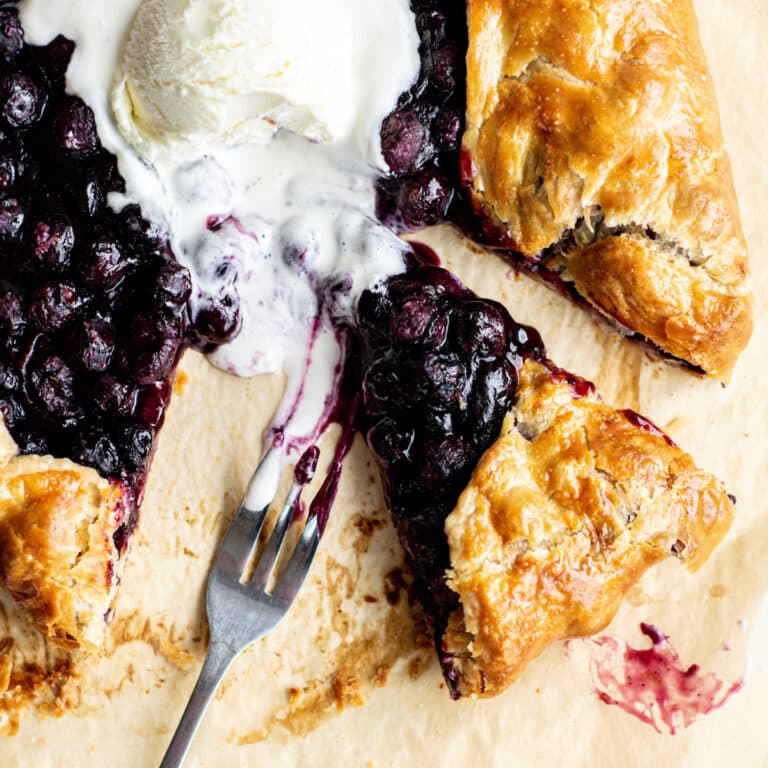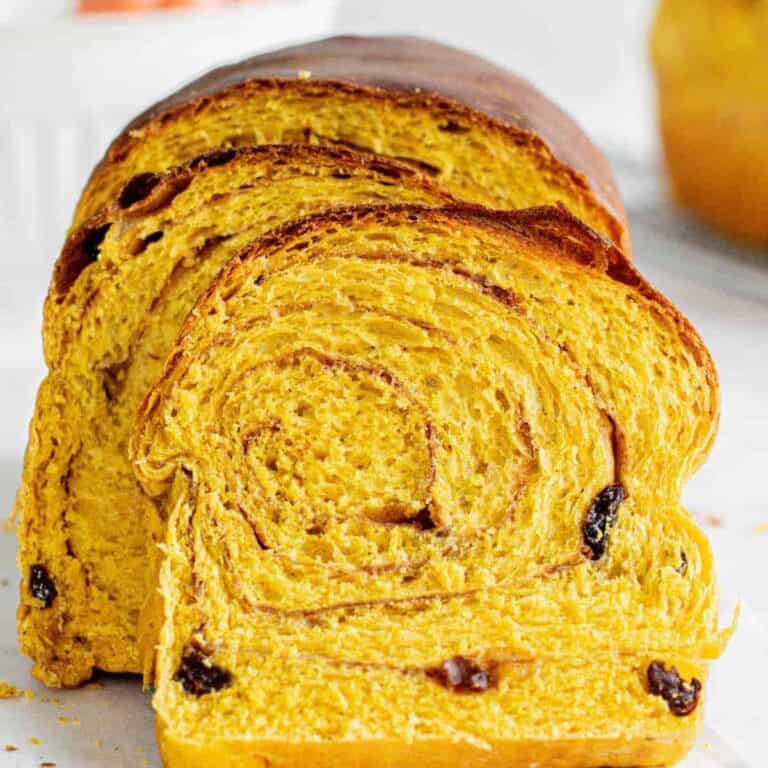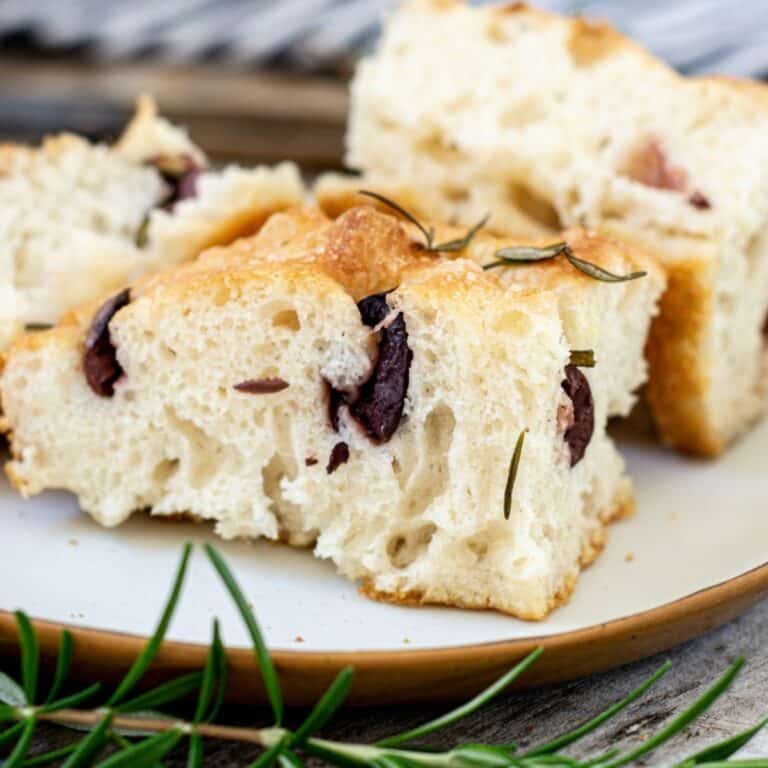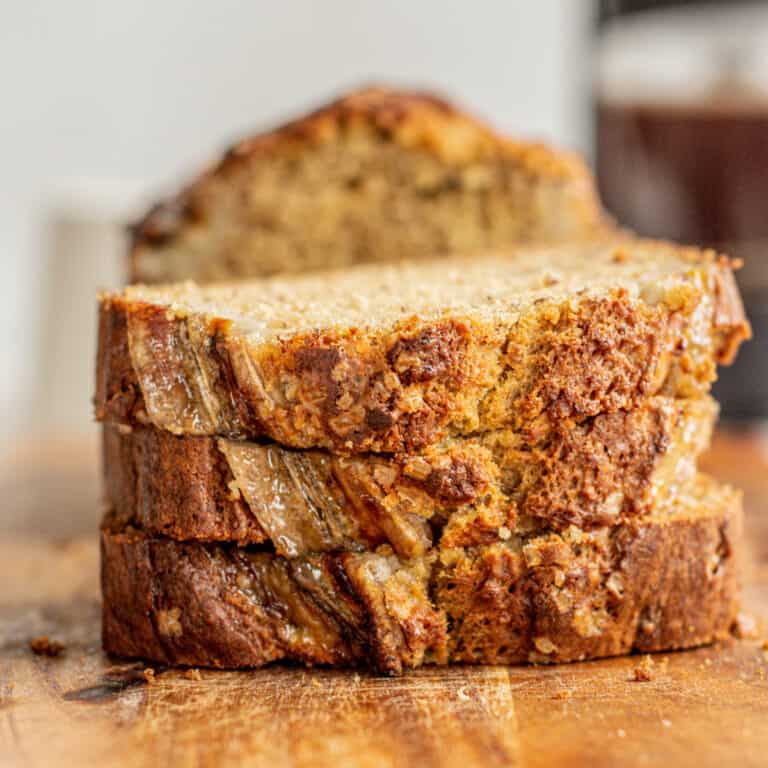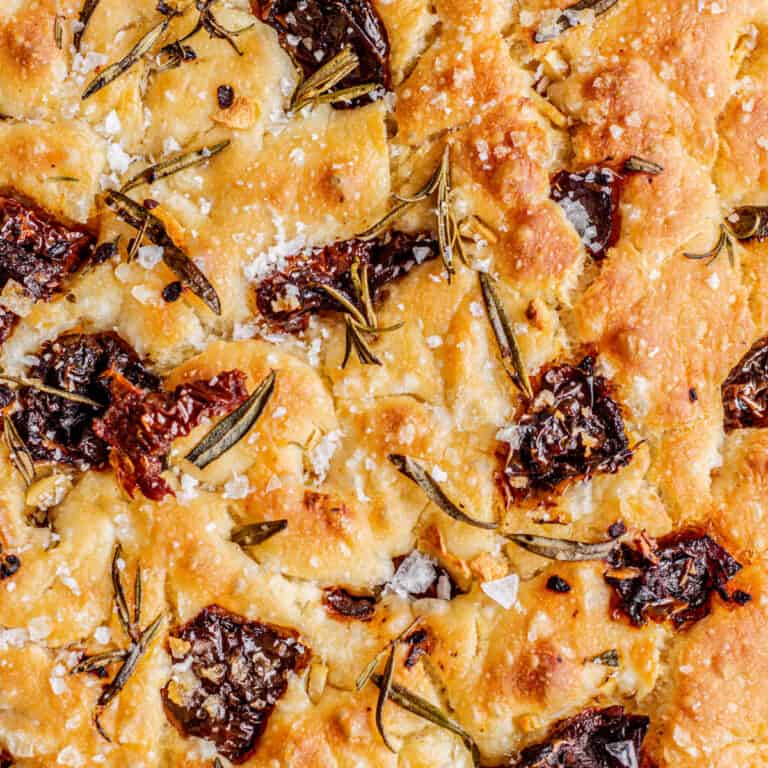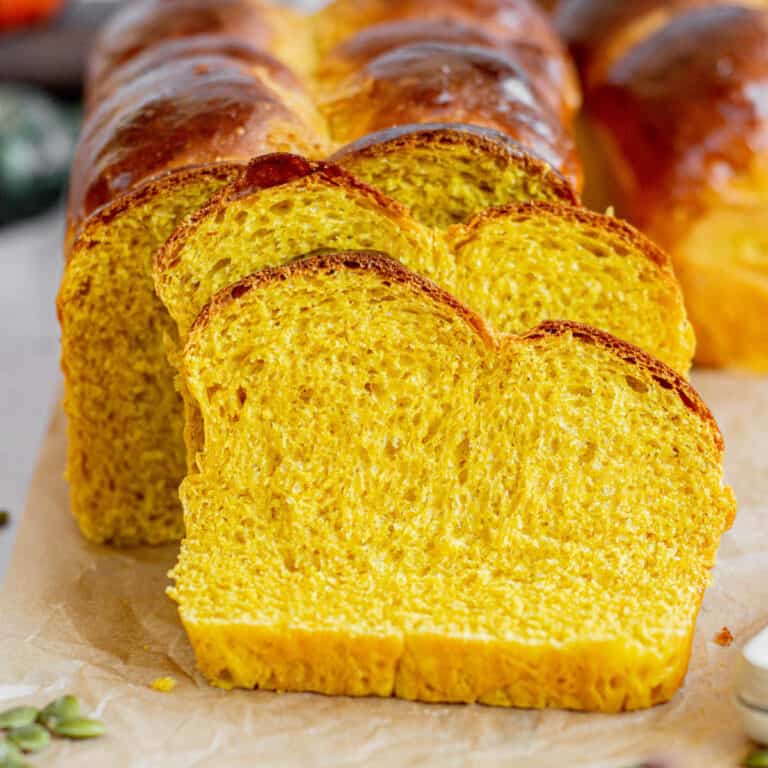Basil Pesto Focaccia Bread
This basil pesto focaccia bread tastes amazing and it’s so easy to make! The bread is light and airy with a golden crust and pesto topping.
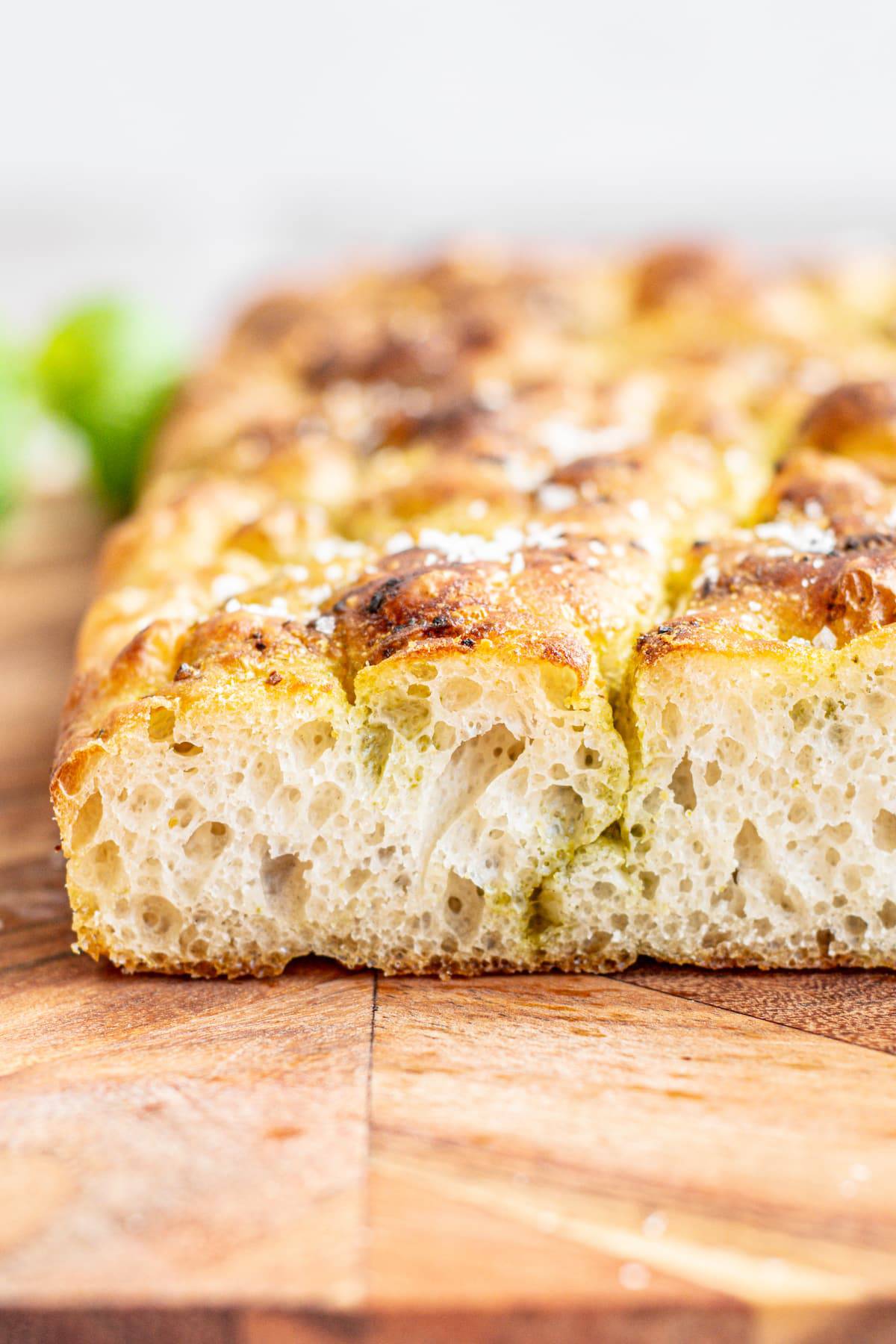
Homemade focaccia bread is one of the easiest bread to make and one with the most flavor. It’s made by hand, but there’s no kneading involved. Wet dough is stretched and folded over itself to create the structure.
The dough hydration
The dough has around 91% hydration. This high hydration dough forms a really airy bread with lots of air pockets. The bottom and sides of the dough are crisped in extra virgin olive oil and the top of the dough is coated in basil pesto.
This recipe is based on this easy focaccia bread recipe, but with a slight increase in dough size.
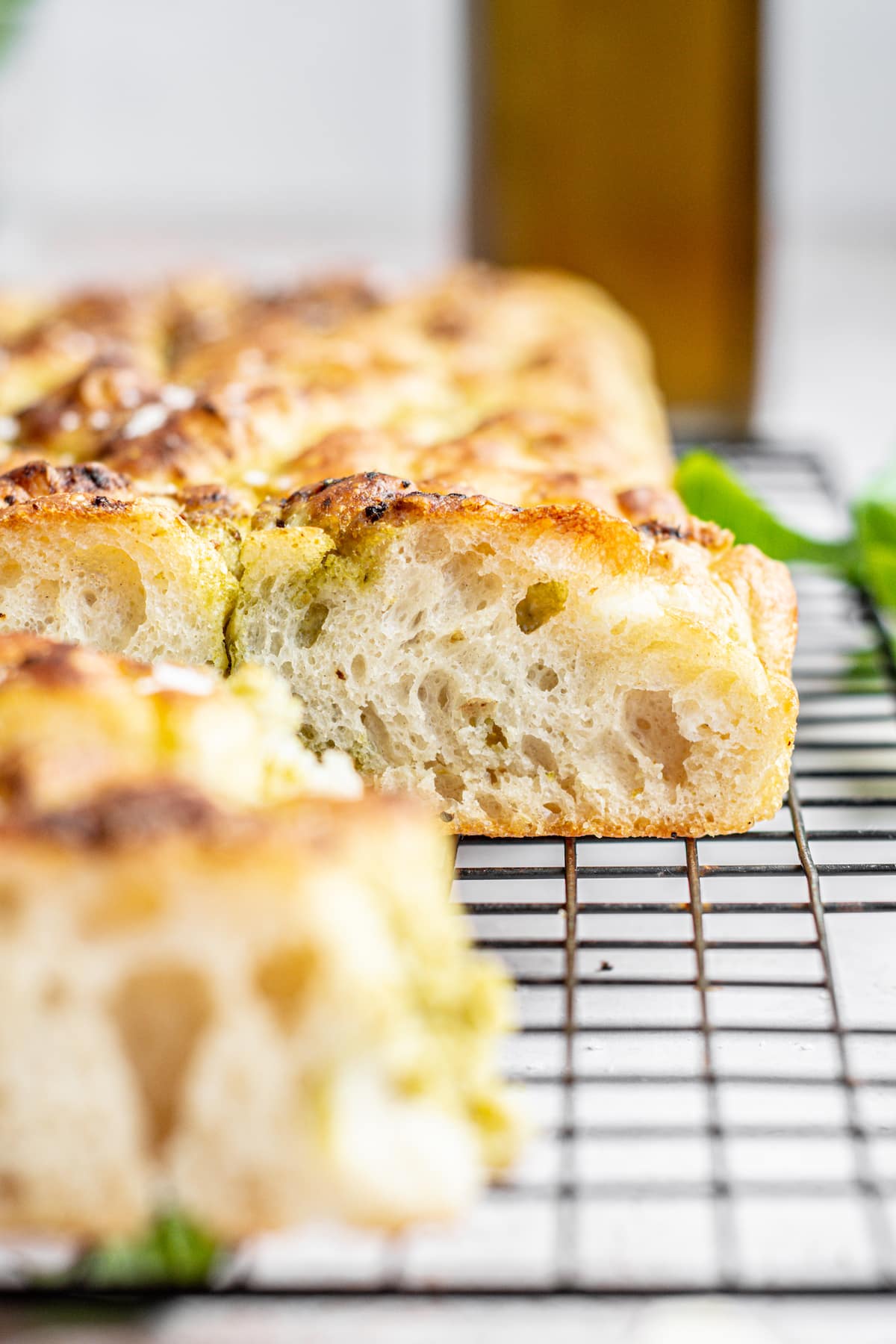
Ingredients
Find the amounts of the ingredients in the printable recipe card at the bottom of this post. Here is a run down of what you will need.
- All-purpose flour – a strong all-purpose flour can be used in this recipe. Check the protein level, a flour with a protein level of at least 11% is best. You can also use bread flour, or a mix of both bread and all-purpose flour.
- Water – This dough has very high hydration and a lot of water is used. This focaccia bread has around 91% hydration. It makes traditional kneading a bit hard, so a stretch and fold method will be used.
- Salt – The salt adds flavor and strength to the gluten. Flaky sea salt is also added later as a topping.
- Yeast – instant yeast or an active dry yeast can be used. This will create a rise in the focaccia bread.
- Extra-virgin olive oil – the bread is lavishly coated in a few tablespoons of extra virgin olive oil before it is baked. This creates a fried crust on the outside and adds wonderful flavor.
- Basil pesto – Basil pesto is full of parmesan cheese and chopped nuts, which bring incredible flavors to the focaccia. This can be substituted with pesto of your choice, like sundried tomato pesto, or even olive tapenade.

Equipment
You will need a baking pan or a cast-iron skillet to bake the focaccia bread in. This recipe is using 9x13inch metal baking pan.
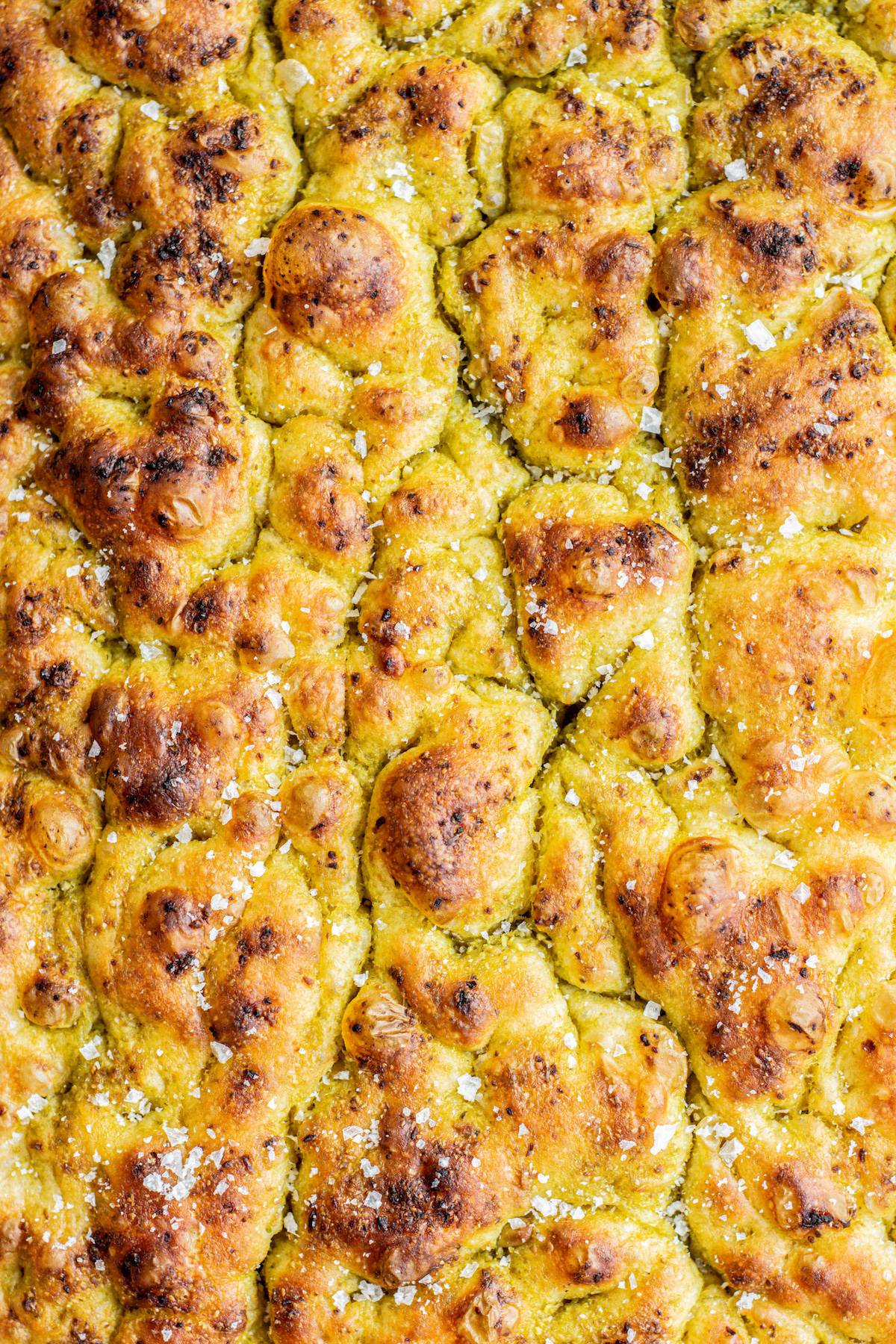
The method
- In a large bowl combine the yeast, lukewarm water, flour, and salt and mix together with a wooden spoon or rubber spatula to create a wet and well-combined, shaggy dough ball.
- Leave it to sit for 15 minutes before applying 4 sets of stretch and folds spread out over an hour, one set every 15 minutes (though this timing isn’t set in stone, don’t worry if it’s less or more!)
- It’s a very wet dough, so do not feel alarmed if it feels sloppy. It will come together as the stretch and folds continue.
Stretch and folds
A stretch and fold method is when one side of the dough is stretched up and pulled over itself. The bowl is then turned a quarter turn and this move is repeated on the following side.
Continue stretching and folding and turning the bowl until all sides have been folded. That is ‘one set’ of stretch and folds.
The first time you perform a set of stretch and folds, the focaccia dough will be very shaggy and the dough will rip easily. As the folds are carried out over the next while, the gluten structure is created and the dough gains strength. Use wet hands when doing this or the dough will stick to you!
By the last stretch and fold there will be a significant difference in texture and the dough should be able to stretch up quite high and feel strong. The dough will also be rising during this period and it will feel airier.
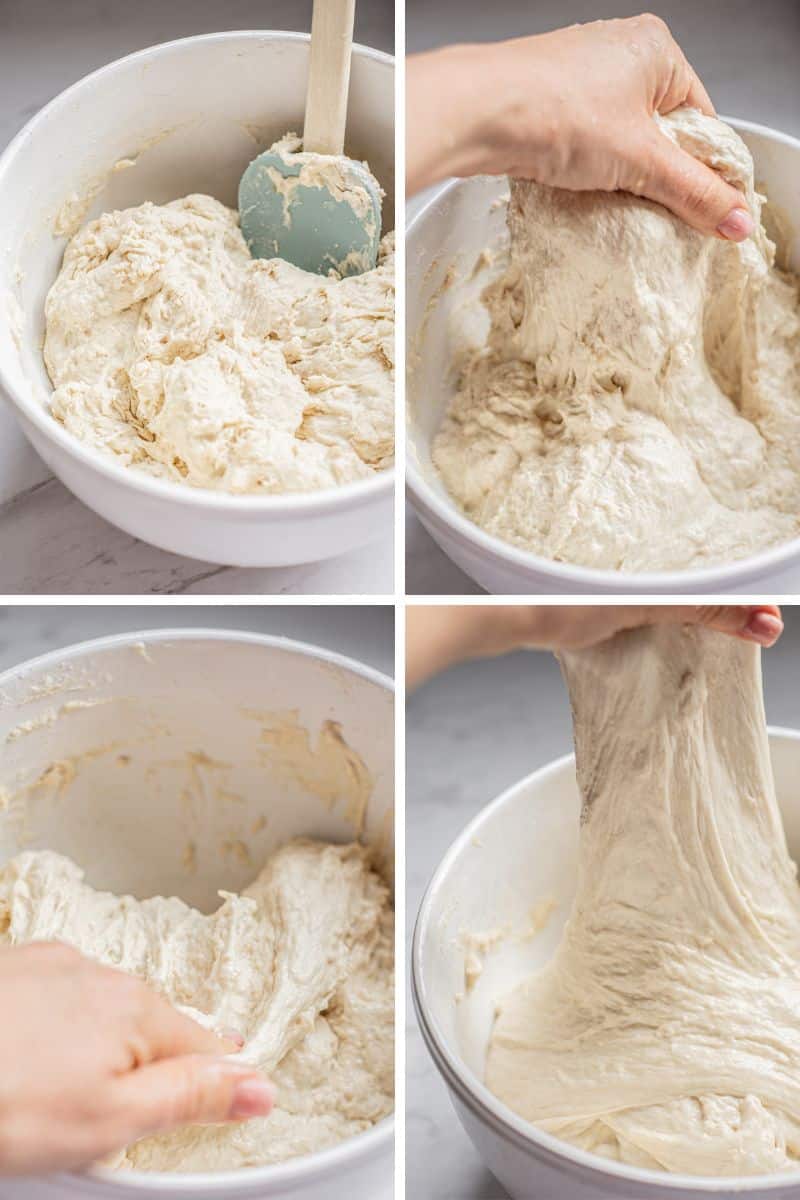
Overnight focaccia (optional step)
For overnight focaccia, the dough can be mixed together in step one, given one set of stretch and folds, and then transferred to the refrigerator overnight. Place the dough in a lightly oiled, big bowl and cover with a lid or cling film.
The following day, transfer dough to an oiled skillet or baking tray and carry on with the second rise (instructions below) and dimpling of the dough.
When the dough first comes from the refrigerator it will be harder to press into the prepared pan, as cold dough springs back. Let the dough rest at room temperature for 10 minutes before pressing it out to fill the pan.
Second rise
- Drizzle the bottom of the pan with a generous amount of olive oil. You can line the pan with parchment paper as well if you think your pan might stick. After the stretch and folds are completed, transfer the dough into the oiled pan.
- Leave it to sit and rest for 5-10 minutes, then use oiled fingers to spread the dough out into the skillet. If the dough resists stretching out, give it a rest and try again in a few minutes.
- Let the dough rise at room temperature for around 1-1.5 hours until it has just doubled and it jiggles when the skillet is shaken. How fast the dough rises will depend on the temperature. It’s always best to watch the dough and not the clock.
- You don’t want it too rise too much or it can become fragile and deflate.
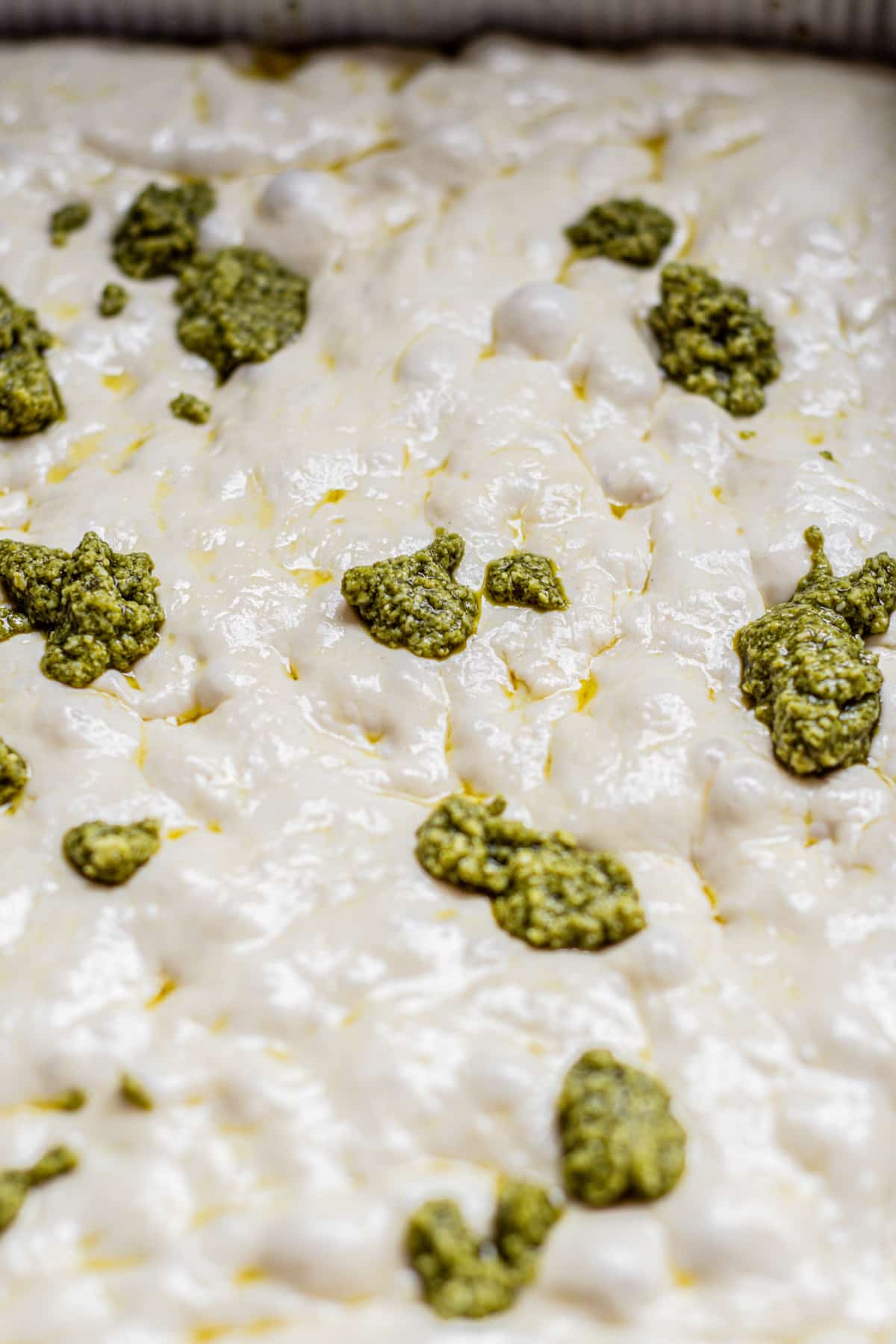
Baking
- Preheat the oven to 450°F/230°C.
- Dollop spoonfuls of basil pesto sauce over the dough. Drizzle a little olive oil over your fingers and use your fingers to spread the pesto out over the dough.
- Then use oiled fingers to create deep dimples on the top of the dough, pushing all the way down. Do this all over the bread.
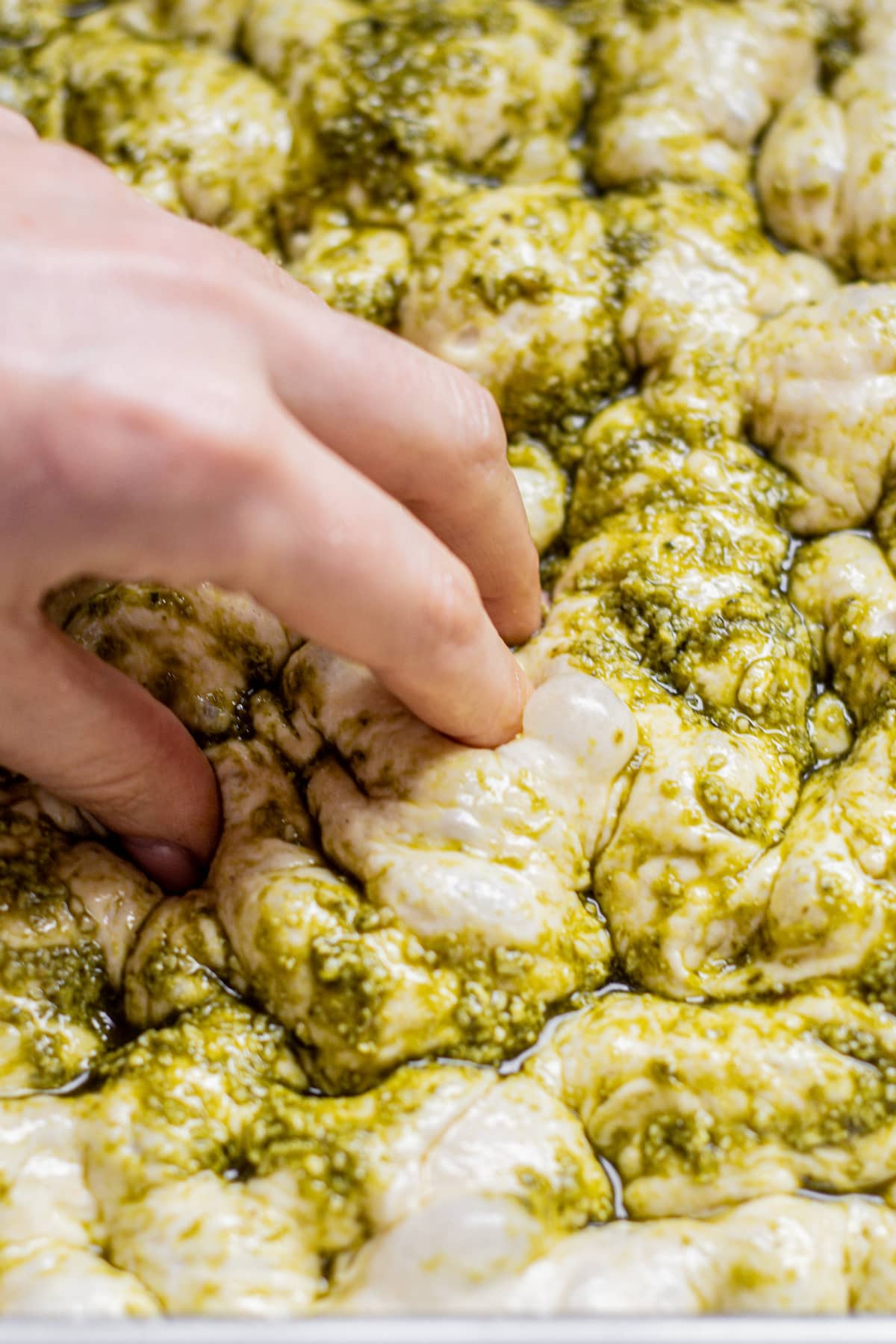
- Bake the focaccia until puffed and deep golden brown and the bread pulls away from the edges of the pan.
- Remove it from the oven and let it sit for 3-4 minutes. Carefully remove it from the skillet or tray, then let it cool further on a wire cooling rack before serving.
Serving and storing
Focaccia bread can be used to make sandwiches, or the dough can be spread out thinner and used as the base for a pizza. It makes an excellent side dish to go with soups, lasagna, and stews. Use the bread to dip into soups or mop up pasta sauces.
Leftover focaccia bread can be wrapped tightly and stored at room temperature for up to three days. It can also be frozen for up to three months.
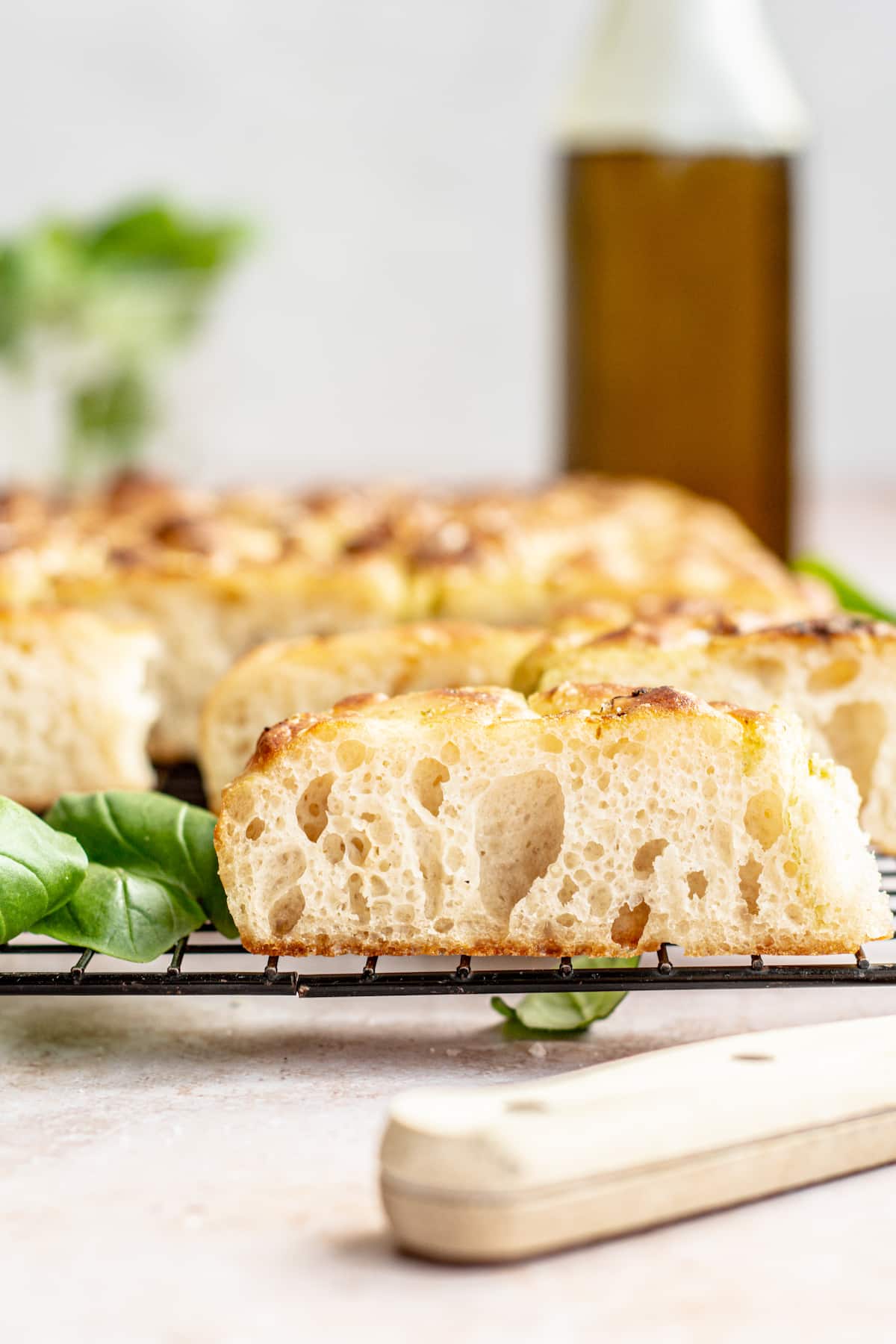
Related recipes
- Fluffy Focaccia with Tomatoes and Onion
- Easy Fougasse Recipe
- The Softest Pull-Apart Pesto Bread
- Easy Cheese Scones – Super Flaky
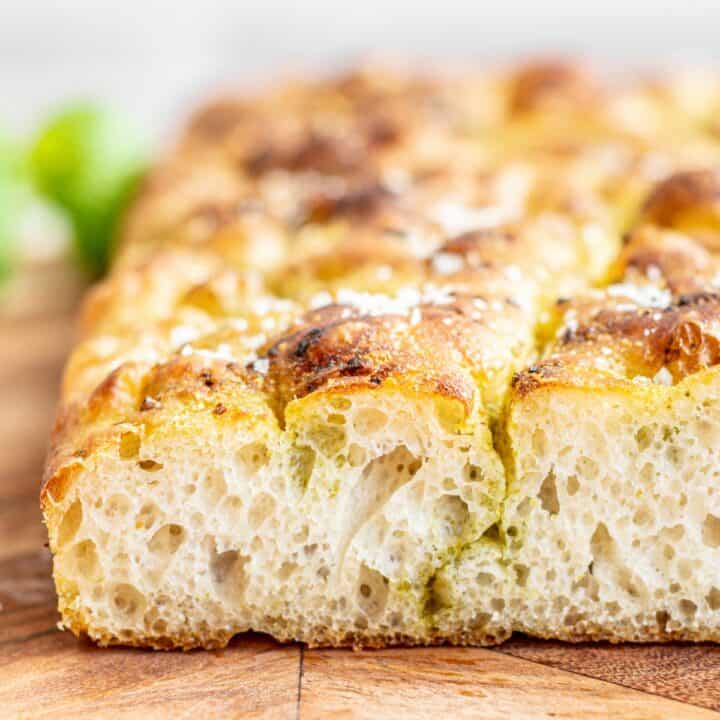
Pesto Focaccia
This basil pesto focaccia bread tastes amazing and it's so easy to make! The bread is light and airy with a golden crust and pesto topping.
Ingredients
- 510g (2 cups plus 2 Tbsp) lukewarm water
- 2 teaspoons instant or active dried yeast
- 560g (4 ½ cups) all-purpose flour or bread flour with a protein level of at least 11%
- 1 ½ teaspoon fine salt
Toppings
- 4 Tablespoons extra virgin olive oil
- 60g (1/4 cup) basil pesto
- Flaky salt
Instructions
- In a large bowl combine the yeast, lukewarm water, flour, and salt and mix together with a wooden spoon or rubber spatula to create a wet and well-combined, shaggy dough ball. If using active dried yeast, let it dissolve in the lukewarm water for 5 minutes before mixing it with the rest of the dough ingredients.
- Leave it to sit for 15 minutes before applying 4 sets of stretch and folds spread out over an hour, one set every 15 minutes (though this timing isn't set in stone, don't worry if it's less or more!) Use wet hands when doing this or the dough will stick to you!
A stretch and fold method is when one side of the dough is stretched up and pulled over itself. The bowl is then turned and this move is repeated on the following side.
Continue stretching and folding and turning the bowl until all sides have been folded. That is one set of stretch and folds.
The first set of stretch and folds will be very shaggy and the dough will rip easily. As the folds are carried out over the next while, the gluten structure is created and the dough gains strength.
- Drizzle the bottom of a 9x13 inch pan with a generous amount of olive oil. You can line the pan with parchment paper as well if you think your pan might stick. Transfer the dough into the oiled pan. Leave it to sit and rest for 5-10 minutes, then use oiled fingers to spread and stretch the dough out into the skillet. If the dough resists stretching out, give it a rest and try again in a few minutes.
- Let the dough rise at room temperature for around 1-1.5 hours until it has just doubled and it jiggles when the pan is shaken. How fast the dough rises will depend on the temperature. It's always best to watch the dough and not the clock. Don’t let let it rise too much or the dough can become too fragile and deflate.
- Preheat the oven to 450°F/230°C.
- Dollop spoonfuls of basil pesto over the dough. Drizzle a little olive oil over your fingers and use your fingers to spread the pesto out over the dough. Then use oiled fingers to create deep dimples on the top of the dough, pushing all the way down. Do this all over the bread. Sprinkle with flaky salt.
- Bake the focaccia for 25-30 minutes until puffed and deep golden brown and the bread pulls away from the edges of the pan. If the pesto starts browning too much on top, loosely cover the bread with aluminum foil.
- Remove the focaccia from the oven and let it sit for 3-4 minutes. Carefully remove it from the skillet or tray, then let it cool further on a wire cooling rack before serving.
Nutrition Information:
Yield: 10 Serving Size: 1Amount Per Serving: Calories: 286Total Fat: 9gSaturated Fat: 1gTrans Fat: 0gUnsaturated Fat: 7gCholesterol: 2mgSodium: 410mgCarbohydrates: 44gFiber: 2gSugar: 0gProtein: 7g
This is an informational estimate only. I am not a certified Dietitian or Nutritionist
